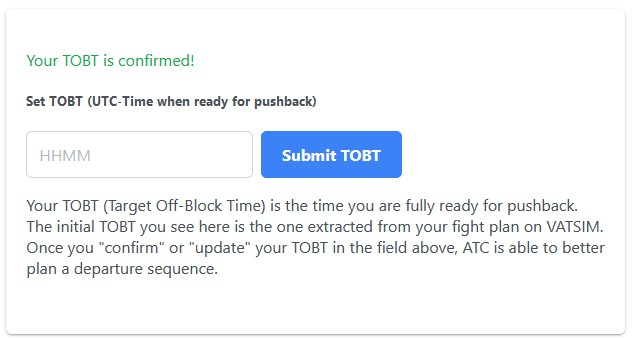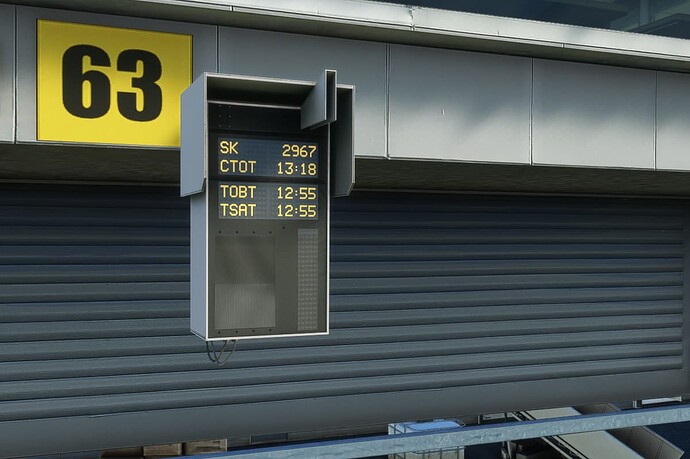Starting from the effective date of AIRAC 2506, the use of A-CDM has been adjusted as follows:
- ZBAA ZSPD ZGGG is no longer operated 24/7, but it is still strongly recommended to use it.
- In principle, the A-CDM system should be used at all event airports.
- Pilots should check ATC INFO/ATIS to obtain notification on whether A-CDM is enabled. When the A-CDM system is enabled, pilots should proactively submit TOBT time. Pilots are responsible for delays caused by failure to proactively submit.
- The controller responsible for apron operations decides whether A-CDM is used at the airport and notifies the controller who has opened ATIS.
- If A-CDM is used at the airport, the controller should indicate that A-CDM is in use in ATC INFO and ATIS.
If you have any questions, please contact the VATPRC Operations Department.
VATPRC Operations Department
2025/06/07
A-CDM Introduction
Airport Collaborative Decision Making (hereinafter referred to as A-CDM) is an operating mechanism led by airports and jointly participated by airlines, air traffic control, ground service companies, etc., based on information sharing and centered on collaborative decision-making. Through the effective control of aircraft ground operation support nodes, the optimization of ground resource allocation, and the improvement of flight ground transit and departure sequencing, the overall improvement of airport ground operation efficiency can be achieved. - Source: CAAC Document No. 68 [2018]
A-CDM is a concept designed to improve the overall efficiency of airports. Although the simulator cannot simulate the complexity of real-world operations, implementing A-CDM on VATSIM can still enhance the overall experience of pilots and controllers while also improving operational efficiency. At the same time, real-time data sharing allows pilots to be informed of their queue status at any time. Pilots submit target off-block time (TOBT) so that controllers can better coordinate.
Use vACDM as a pilot
The system behind ACDM is very complex and it is not necessary for you as the pilot to understand it in every detail. Due to some simulator and network limitations, vACDM also can’t simulate every aspect of its real world counterpart, mainly prohibiting network-wide flow management.
ACDM times
There are many different times used in ACDM procedures. However, we will only list the ones that are relevant for you as the pilot here. Keep in mind that all times are given in UTC.
EOBT (Estimated Off-Block Time)
This is the time when you estimate to be ready for pushback during the creation of your flight plan. ATC will use it as an initial, but unconfirmed indication of when you are going to be ready.
When prefiling from SimBrief, an EOBT will automatically be added to your flight plan. This time will be calculated based on when you start creating your SimBrief flight plan + 30 minutes. If you plan to depart earlier or later, it is recommended to change this time.
TOBT (Target Off-Block Time)
During the preparation of the aircraft, you might realize that you will be ready earlier or later than your original estimate. Keeping your TOBT up to date will help ATC to reduce delays and ensure a smooth operation. When you set a TOBT, ATC will treat it as a confirmed time and calculate your TSAT based on it. If you realize during any part of your preparation that a new estimate will differ more than 5 minutes from the previous one, you should set a new TOBT.
To set your TOBT, please use https://vacdm.vatprc.net/ which allows you to set it on your own. If you did not set a TOBT yourself already, ATC will have to ask you to set your TOBT, which will lead to unnecessary frequency congestion and a visible departure delay.
It is generally good practice to set your initial TOBT 20-30 minutes in advance and request enroute clearance 10-15 minutes before your TOBT to ensure the information is available for ATC planning and that the controller can inform you of any potential delays or slot restrictions ahead of time.
If you do not set a TOBT, ATC might not be able to approve your startup right away when you are ready. Especially during periods of high traffic, not setting a TOBT ahead of time can result in delays for you.
TSAT (Target Startup Approval Time)
This is the time when ATC is planning to approve your startup. Keep in mind that it is ultimately your responsibility as the pilot to request startup within the TSAT window; don’t rely on the controller to call you for your startup. You can always find your current TSAT on the virtual VDGS in the vACDM pilot interface.
In an optimal situation, your TOBT and TSAT will be at the same time. However, if there are more aircraft wanting to depart than the airport can currently accommodate, startups will be delayed and your TSAT will be at a later time than your TOBT.
If you miss your TSAT window (TSAT ± 5 minutes), the gap for departure is lost and a new TSAT has to be generated. Be aware that your TSAT can improve (and occasionally also worsen) depending on the general traffic situation and other aircraft’s TOBTs.
Pushback needs to be requested within 5 minutes of your startup approval. At taxi-out positions you have 10 minutes to call for taxi. After that time the startup approval is invalid and you will be told to recontact Delivery, who has to generate a new TSAT.
CTOT (Calculated Take-Off Time)
This is the actual slot. On VATSIM, you will usually not be issued a CTOT, so it is not a big deal to depart a little bit later or earlier than what ATC had originally planned. However, during some busy events with slot bookings or if there are flow measures in place for your route, you will be given a compulsory CTOT and have to depart in this CTOT window (CTOT - 5/+10 minutes). When you are given a CTOT, it is very important to meet it as another slot might not be available for over an hour.
Using A-CDM system
VATPRC’s A-CDM system website is https://vacdm.vatprc.net , you need to log in using your VATSIM account. The system will then search for your flight in the vACDM database.
Setting your TOBT
Next to the virtual VDGS, you can update your TOBT based on your current estimates. It has to be entered in UTC.
Once you have set your TOBT, it will show as confirmed. We ask pilots to confirm their TOBT at least once and update it every time it changes by more than 5 minutes.
Virtual VDGS
Once your flight is logged in the vACDM process, you will see the virtual VDGS with your flight’s current departure information.
| Content | Explanation |
|---|---|
| CCA777A | Your callsign |
| TOBT 14:56UTC | Current TOBT 14:45 UTC |
| TSAT 14:56UTC | Current TSAT 14:45 UTC |
| -3 | Time to go to (-) or elapsed since (+) your TSAT |
| PLANNED RWY 36R | Planned departure runway 36R |
| SID ELK9ZD | Planned SID ELK9ZD |
Keep in mind that the departure information on the virtual VDGS will only be correct once you have set a TOBT and have received your enroute clearance.
Nool VDGS Compatibility
Nool VDGS is a visual docking guide used in Microsoft Flight Simulator 2020. This plugin needs to be compatible with the scenery developer, so that the relevant time in the A-CDM system can be directly transmitted to the flight simulator.
Currently, no scenery developer has compatible with this plugin in the VATPRC airspace, but we believe that in the near future, various paid/free scenery will be compatible with this. For a list of supported airports, see → here
Pilot Guide
- Submit flight plan and connect to the server normally
- After connecting, log in to https://vacdm.vatprc.net and submit TOBT or report TOBT to ATC after you have received the departure clearance
- After completing initial preparation, request for en-route clearance
- After readback, check the virtual VDGS to verify whether TSAT, runway, SID, etc. are correct
- If the information is not correct, please contact the controller in time
- If you need to change TOBT, please change it at this time
- Apply for push/start 0-5 minutes before TSAT
- Taxi and depart
- You can request a TTOT time from the controller so that you can take off as close to the TTOT time as possible.
Pilots should push/start as close to TSAT as possible and avoid exceeding TSAT
ATC may change the TOBT, but it will never be changed earlier than the original time
The local circuit flight does NOT use the A-CDM system
If you have any questions, please contact the VATPRC Operation Department.
VATPRC Operation Department
2024/08/27




